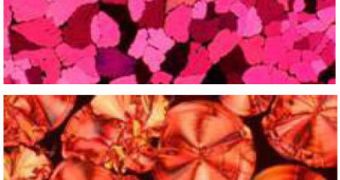A team of experts in the United Kingdom has recently demonstrated that it is possible to use discotic liquid crystals (DLC) to produce molecular nanowires.
DLC are thin strips of ring-shaped molecules, that can apparently be fashioned into the nanoscale-sized wires, for a wide variety of practical applications.
According to researchers at the University of Leeds, who perfected the new technique, it could be that the innovation will play an important role in the development of a new generation of electronic devices.
These devices may include low-cost biosensors, that would be used in the developed world to test drinking water quality, thus potentially saving thousands of lives annually.
Cells that are capable of harvesting light with great efficiency may also become a reality in the near future, Science Blog reports.
These applications, and many others, are possible due to the fact that DLC are some of the most promising materials that experts believe can be used to produce organic electronic devices.
But one of the main obstacles that stood in the path of using these molecules on a wide scale was controlling their overall alignment.
“DLC molecules have a tendency to stack on top of each other like a pile of coins,” explains University of Leeds research and professor Stephen Evans, who was a member of the research group.
“But the difficulty comes in controlling the orientation of such columnar stacks with respect to the surface on which they lie. This is crucial for their future application,” the scientist goes on to say.
“Traditionally, scientists have tried to get DLC to align simply by rubbing the surface they sit on with a cloth to create micro grooves,” he explains.
“This fairly primitive method works fine for macroscopic areas, but for new generations of devices we need to accurately control how liquid crystal arranges itself on the surface,” Evans adds.
The team at the university basically developed a new method of molecular wire production, that allows them to selectively control this alignment by using patterned surfaces.
Now, the DLC piles can be stacked neatly on top of each other, which means that nanoscale wires can be produced easier than ever before.
“By changing the surface properties we can get switch between alignments which is very interesting from the point of view or sensing devices,” says Evans.
“Most biosensors require a backlight to see when a change has occurred, but it is very easy to see when a liquid crystal has changed direction – you just hold it up to the light,” he explains.
“This opens up great possibilities for the production of very simple and, more importantly, cheap biosensors that could be widely used in the developing world,” the team leader adds.
The new investigation was conducted with funds secured from the UK Engineering and Physical Sciences Research Council (EPSRC).
Details of the groundbreaking work are published in a recent issue of the esteemed scientific journal Advanced Functional Materials.

 14 DAY TRIAL //
14 DAY TRIAL //